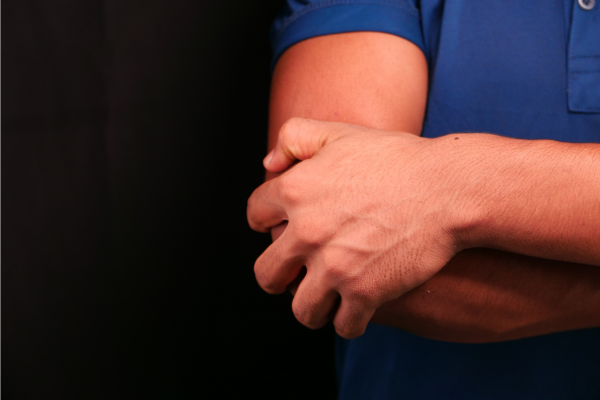What is Tennis Elbow?

Tennis elbow, formally known as lateral epicondylitis, is a common and painful condition that primarily affects the outer part of the elbow. It is characterized by pain and tenderness around the lateral epicondyle, which is the bony prominence on the outer aspect of the elbow. This condition is not exclusive to tennis players, despite its name, and can affect individuals from various walks of life. Its prevalence has been on the rise in recent years.
Can Tennis Elbow cause wrist pain?
Tennis elbow can cause wrist pain, although the primary location of pain is typically on the outer part of the elbow. Tennis elbow is an overuse injury that affects the tendons and muscles of the forearm, particularly those that attach to the humerus bone in the elbow. Because the forearm tendons and muscles are interconnected and play a role in wrist movement, the strain and inflammation associated with tennis elbow can lead to secondary symptoms, including tennis wrist pain. Here’s how tennis elbow can potentially contribute to wrist pain:
Muscle and Tendon Interaction: The muscles and tendons involved in tennis elbow are part of the same muscle group responsible for wrist extension. When these muscles and tendons become inflamed and painful due to tennis elbow, it can affect their function and, consequently, wrist movement.
Altered Movement Patterns: To compensate for the pain in the affected forearm, people with tennis elbow may unconsciously alter their wrist and hand movement patterns. These can place additional stress on the wrist and lead to wrist pain.
Radiating Pain: Sometimes, tennis elbow pain can radiate or refer to nearby areas, including the wrist. This can create the sensation of pain in both the elbow and the wrist.
Overuse: Activities that contribute to tennis elbow, like repetitive gripping and wrist extension, can also strain the wrist joint and surrounding structures, leading to concurrent wrist pain.
While wrist pain associated with tennis elbow is possible, it’s important to distinguish between the two conditions and receive a proper diagnosis from a healthcare provider. Other conditions, such as wrist tendonitis or carpal tunnel syndrome, can also cause wrist pain.
How do I know if I have Tennis Elbow?

Symptoms of tennis elbow are:
– Pain: The primary symptom is pain on the outer part of the elbow, specifically near the bony bump called the lateral epicondyle. This pain can range from mild discomfort to severe and may worsen with gripping or lifting objects.
– Weakness: Some individuals with tennis elbow experience weakness in their grip strength, making it challenging to perform everyday tasks.
– Stiffness: Stiffness in the elbow joint may accompany the pain, especially in the morning or after periods of inactivity.
– Tenderness: The area around the lateral epicondyle can be tender to the touch.
What triggers or exacerbates Tennis Elbow pain?
Tennis elbow develops due to repetitive motions or activities that involve gripping and wrist extension, such as tennis, painting, plumbing, typing, or carpentry. The repeated strain on the forearm tendons can cause small tears or inflammation, leading to the symptoms of tennis elbow.
Does Tennis Elbow heal on its own?
Recovery time for tennis elbow can vary significantly from person to person, and without proper care, symptoms may persist or worsen. Rest, avoiding activities that exacerbate symptoms, and using ice can help reduce inflammation and promote healing. In more severe cases or when symptoms persist, invasive surgery and physical therapy may be necessary to resolve tennis elbow pain relief.
Can you get Tennis Elbow pain from activities other than tennis or golf?
Tennis elbow is not limited to just tennis players or golfers; it can occur in anyone who repeatedly uses their forearm muscles and tendons, leading to overuse and strain. This condition typically develops over time.
How can the Ficor Fit band help relieve Tennis Elbow pain?
The FICOR Fit band is a wristband designed to help relieve tennis elbow pain. By applying pressure on the affected tendons, the FICOR Fit band reduces stress on injured tendons. Compression from the band increases blood flow to the area, supporting and stabilizing tendons and muscles affected by tennis elbow while reducing inflammation and pain during movement. FICOR Fit lowers muscle fatigue by providing external support to the forearm muscles. The Ficor Fit wristband comes in a range of sizes and is made of Thermo Plastic Elastomer (TPE). The wind-wire dial allows easy control and release of pressure while the sides of the band place pressure on the two-column bones for stabilization.
Is it okay to wear the FICOR Fit band at night for Tennis Elbow pain relief?
Wearing a FICOR Fit wristband at night provides continuous support and compression for tennis elbow pain relief. Our wristband reduces swelling and inflammation in tendons and muscles, helping to stabilize the joint and reduce strain while sleeping. By limiting movements during sleep, the wristband can prevent accidental aggravation of Tennis Elbow, allowing the affected area to rest and recover. The
FICOR Fit wristbands alleviate pain and discomfort during night and day while wearing a stylish and comfortable wristband that blends in with your lifestyle.

